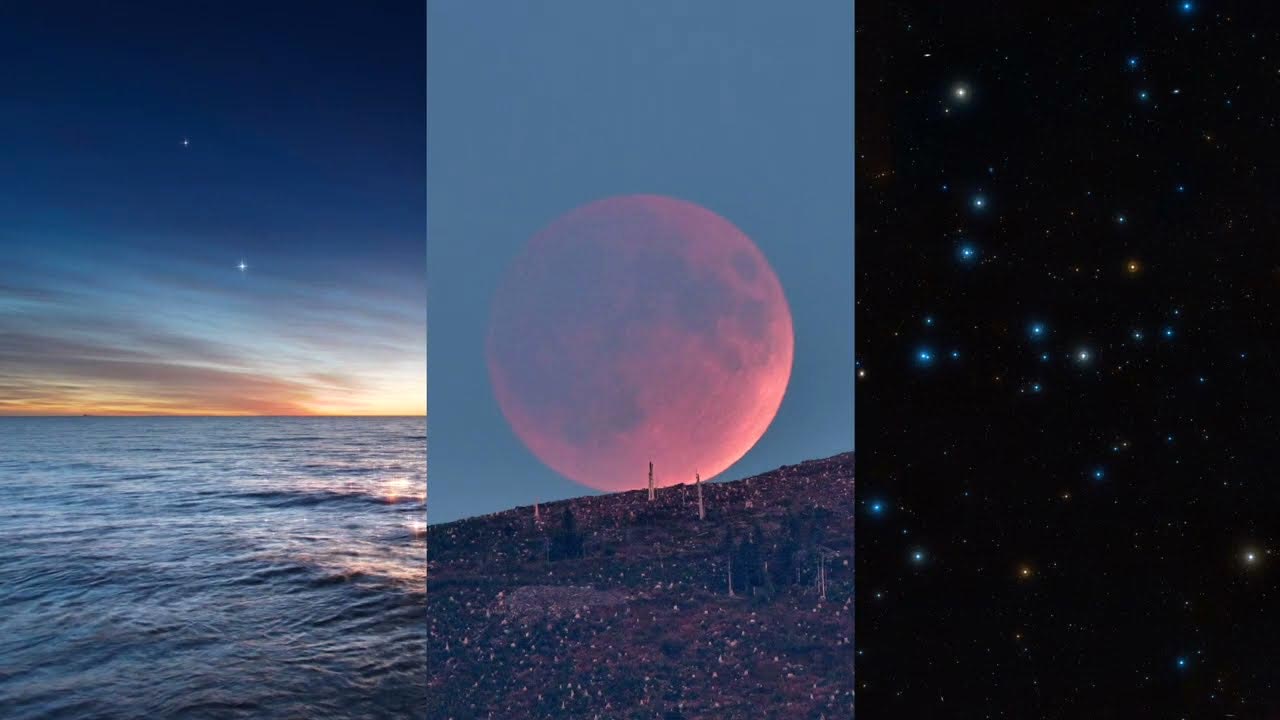Co się dzieje w maju? Planety zmierzch i świt, zaćmienie Księżyca i gromada gwiazd w stanie komy.

Mapa nieba Merkury pojawia się nisko na zachodnim niebie 2 maja, w towarzystwie półksiężyca i jasnej gwiazdy Aldebaran. Źródło: NASA/JPL-Caltech
Może zaczynać się i kończyć dwiema wspaniałymi okazjami do odkrycia planety. 2 maja spójrz na zachód około 45 minut po zachodzie słońca, aby znaleźć Merkurego około 10 stopni od horyzontu, któremu towarzyszy cienki sierp księżyca. Nieco na południe od Księżyca znajduje się jasny czerwony olbrzym Aldebaran, który powinien mieć mniej więcej taką samą jasność jak Merkury. (A tak przy okazji, to jedyna szansa na dostrzeżenie planety gołym okiem wczesnym wieczorem do sierpnia.)

Mapa nieba pokazuje, jak Jowisz i Mars pojawią się bardzo blisko na porannym niebie w dniach 28-30 maja. Źródło: NASA/JPL-Caltech
Następnie w ostatnim tygodniu maja możesz oglądać codziennie rano jak[{” attribute=””>Jupiter and Mars get increasingly close in the predawn sky. Their morning meetup culminates in a close conjunction that you can watch on the 28th through the 30th, where they’ll be separated by barely the width of the full moon. Should look incredible with binoculars, where you can also see Jupiter’s largest moons.
Skywatchers in the Western Hemisphere can look forward to a total lunar eclipse in mid-May. The event will be visible across the Americas, Europe, and Africa – basically anywhere the Moon is above the horizon at the time.
The visible part of the eclipse begins about 10:30 p.m. U.S. Eastern time on May 15th, with totality starting an hour later and lasting for about an hour and a half. Those in the Eastern U.S. will see the eclipse start with the Moon well above the horizon. For the Central U.S., the eclipse starts about an hour and a half after dark, with the Moon relatively low in the sky. On the West coast of the U.S., the Moon rises with totality beginning or already underway, so you’ll want to find a clear view toward the southeast if viewing from there.
Now, lunar eclipses are the ones that are safe to look at directly with your eyes, binoculars, or a telescope (unlike solar eclipses).
The Moon takes on a dim, reddish hue during the period of totality. Even though the Moon is fully immersed in Earth’s shadow at that time, red wavelengths of sunlight filter through Earth’s atmosphere and fall onto the Moon’s surface. One way to think of this is that a total lunar eclipse shows us a projection of all the sunrises and sunsets happening on the planet at that moment.
So check your local details for this eclipse, and find lots more eclipse info from NASA at this link.
Finally in May, a really nice target for binoculars: the Coma star cluster. This loose, open star cluster displays 40 or 50 stars spread over a region of sky about three finger-widths wide. The brightest stars in the cluster form a distinctive Y shape, as seen here.

Sky chart showing where to find the Coma star cluster in May. The cluster is about 6° wide, and is located about 15° east of the hindquarters of Leo, the lion constellation, which is found high overhead in the south. Credit: NASA/JPL-Caltech
The Coma star cluster is located about 300 light-years away, making it the second-closest open cluster to Earth after the Hyades cluster in Taurus.
To find the Coma star cluster, look southward for the constellation Leo. It can be easiest to start from the Big Dipper, toward the north, and use the two “pointer stars” on the end which always point you toward Leo. Once you’ve identified Leo, the Coma star cluster is about 15 degrees to the east of the triangle of stars representing the lion’s hindquarters. It’s relatively easy to find with binoculars, even under light-polluted urban skies – as long as it’s clear out.
So here’s wishing you clear skies for finding the Coma star cluster and any other wonders you discover in the night sky in May.

„Certyfikowany guru kulinarny. Internetowy maniak. Miłośnik bekonu. Miłośnik telewizji. Zapalony pisarz. Gracz.”












More Stories
Firma zajmująca się planowaniem powierzchni handlowych CADS postrzega technologię jako odpowiedź na Święta Wielkanocne i inne sezonowe wyzwania w 2024 r. — Retail Technology Innovation Hub
Astronomowie odkryli, że woda unosi się w części przestrzeni, która tworzy planetę
Tęskniłam za nim bardzo długo! Satelita NASA i martwy rosyjski statek kosmiczny zbliżają się do siebie na swojej orbicie